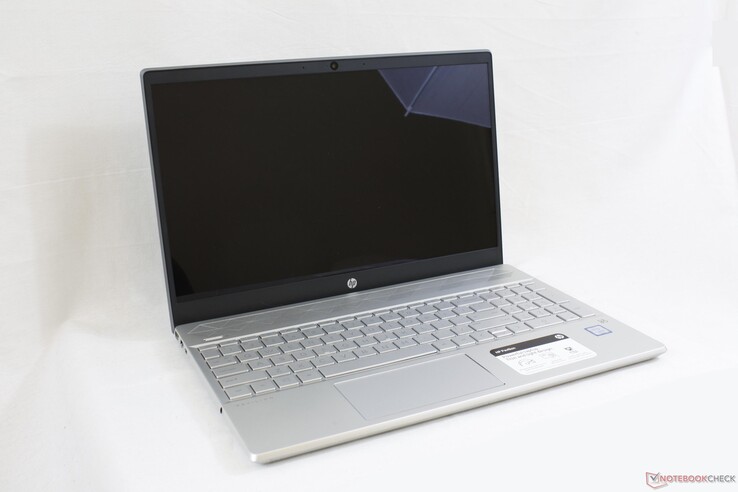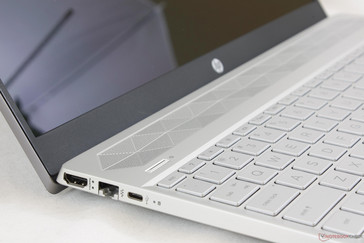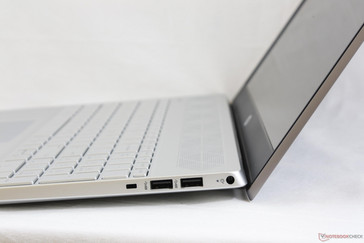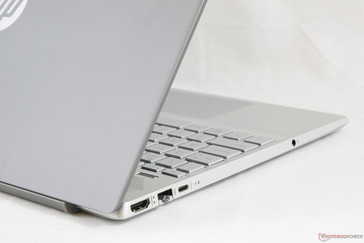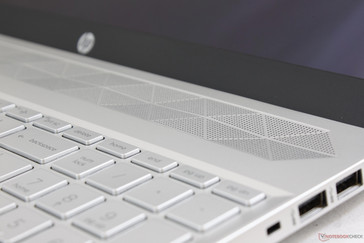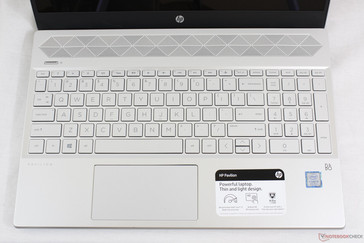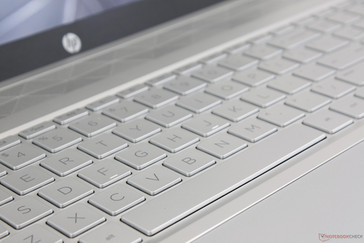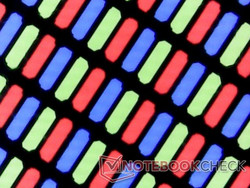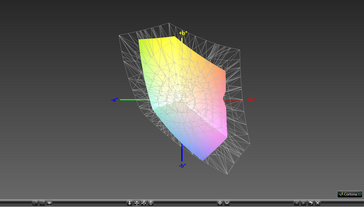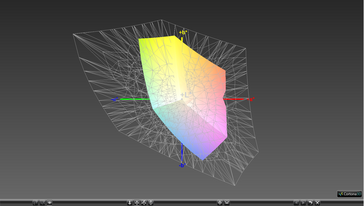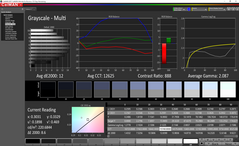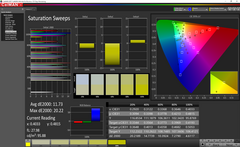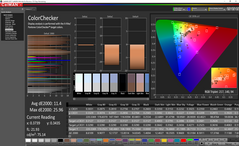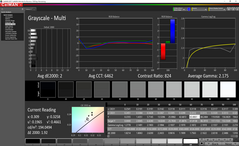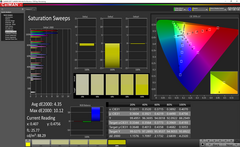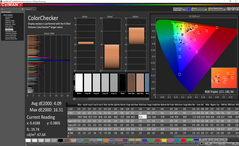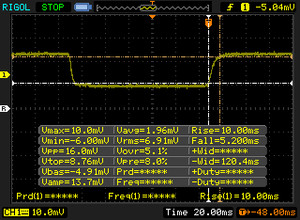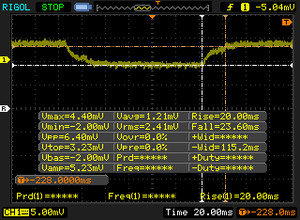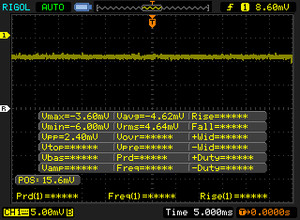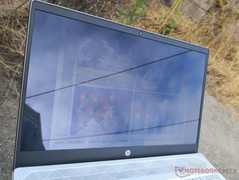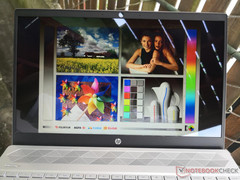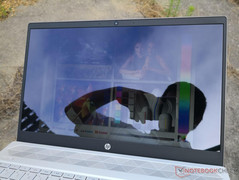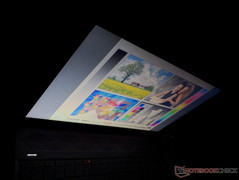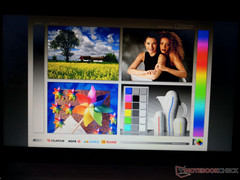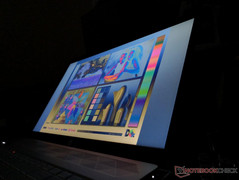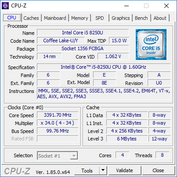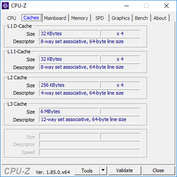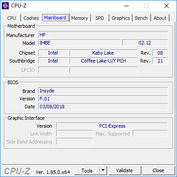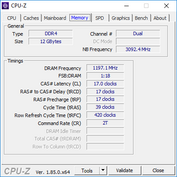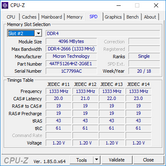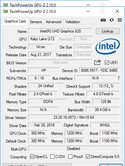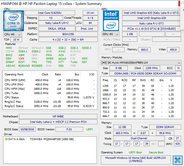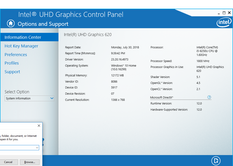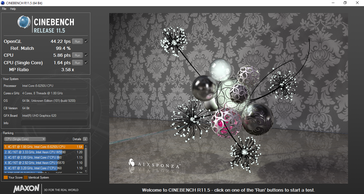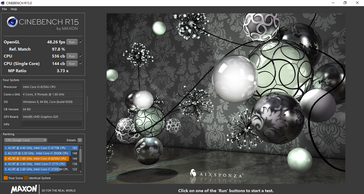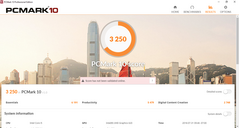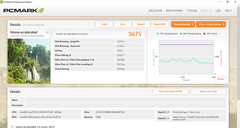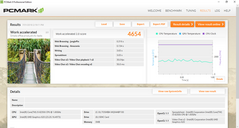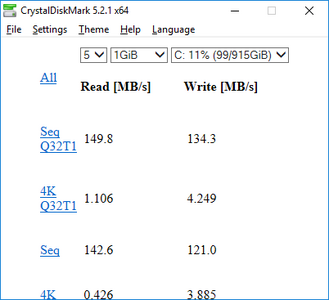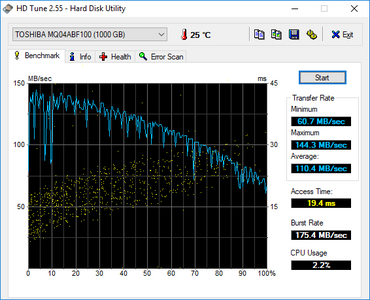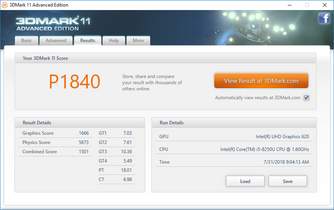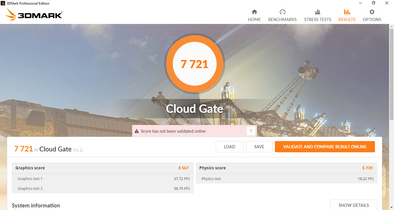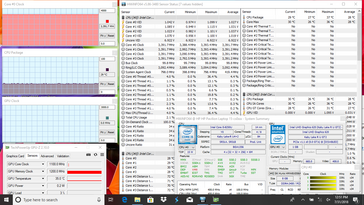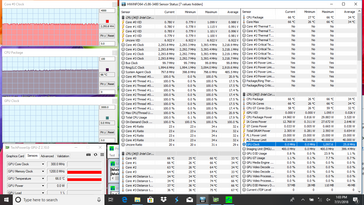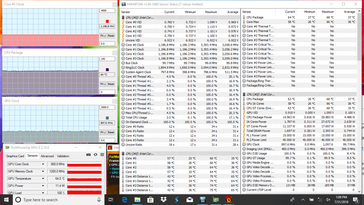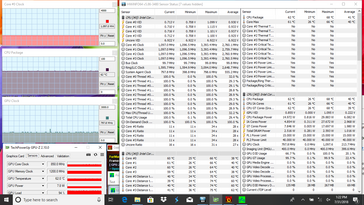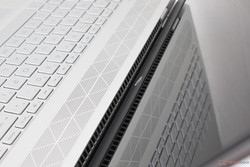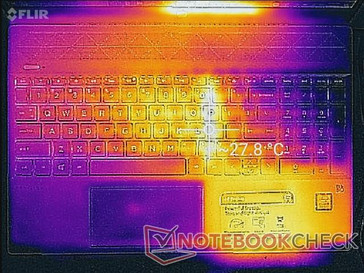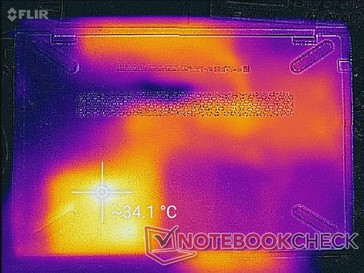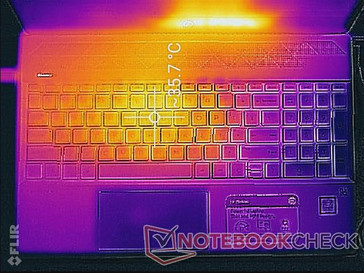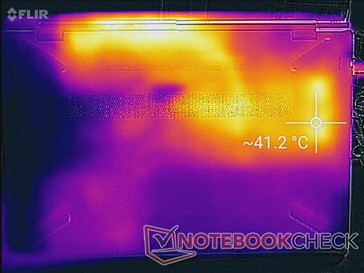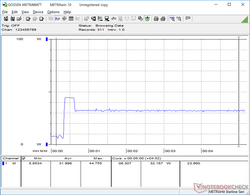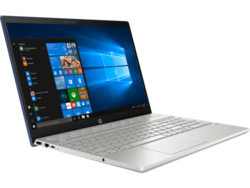HP Pavilion 15-cs0053cl (i5-8250U, HD) Laptop Review

The HP Pavilion is the manufacturer's low-end offering for users on tight budgets. There are new iterations almost every year often with features carried down from the higher-end Envy or Spectre families. Our unit today is a brand new design and possibly the best-looking one yet when compared to the overly plastic appearance of previous models.
The 2018 Pavilion 15 can be configured with a Core i5-8250U CPU, integrated UHD Graphics 620, and 768p display for under $600 or up to a Core i7-8550U, GeForce MX150 GPU, and 1080p display for $1150 USD. Our system for this review is the entry-level configuration. Competitors in this space are plentiful including the Acer Aspire 3 A315, Asus VivoBook 15 K570UD, Dell Inspiron 15, and Lenovo IdeaPad 720.
Reviews on previous HP Pavilion 15 systems:
Case
The new design does away with the rounded edges and corners of previous Pavilion 15 notebooks in favor of a sharper and smoother look. The matte aluminum-like surfaces give a much classier impression that feels close to the Envy series. It's a good attempt at emulating what HP's more expensive laptops have to offer without necessarily using the same unibody materials. Many of the bright color options commonly associated with older Pavilion laptops, however, are nowhere to be found on this latest iteration.
As for rigidity, the system is quite strong around the base with no creaking and only minimal warping on the palm rests and keyboard. The lid is also stronger than before, though it's still susceptible to warping when pushing down its center. The weakest characteristic of the new design is indubitably its hinges. The display opens to a maximum of only 130 degrees and the bottom of the lid will lift the base at a slight angle that HP claims will improve cooling and typing posture. The main issue is that teetering is amplified and the hinges never feel very stiff as a result.
Perhaps unsurprisingly, the new Pavilion 15 is thinner (17.8 mm vs. 22.5 mm) and lighter (1.8 kg vs. 2.1 kg) than the previous generation Pavilion 15t-au100. The narrow bezels contribute immensely to the improved portability of the system.
Connectivity
HP has dropped one USB Type-A port from the outgoing design in favor of one USB Type-C port. DisplayPort over USB is not supported here, but at least the full-size HDMI port remains. Port positioning is excellent as the ports are easy to reach and evenly distributed along the edges. We're disappointed that charging over USB Type-C is not supported as it would have made the proprietary AC adapter port obsolete.
SD Card Reader
The spring-loaded SD card reader is slow at just 38 MB/s with our Toshiba UHS-II test card. Transferring 1 GB worth of images from card to desktop takes almost 30 seconds. A fully inserted SD card will protrude by only a millimeter or so for safe transporting.
| SD Card Reader | |
| average JPG Copy Test (av. of 3 runs) | |
| Dell XPS 15 9570 i7 UHD (Toshiba Exceria Pro SDXC 64 GB UHS-II) | |
| HP Spectre x360 15-ch011nr (Toshiba Exceria Pro SDXC 64 GB UHS-II) | |
| HP Pavilion 15-cs0053cl (Toshiba Exceria Pro SDXC 64 GB UHS-II) | |
| maximum AS SSD Seq Read Test (1GB) | |
| HP Spectre x360 15-ch011nr (Toshiba Exceria Pro SDXC 64 GB UHS-II) | |
| Dell XPS 15 9570 i7 UHD (Toshiba Exceria Pro SDXC 64 GB UHS-II) | |
| HP Pavilion 15-cs0053cl (Toshiba Exceria Pro SDXC 64 GB UHS-II) | |
Communication
The RealTek adapter includes Bluetooth 4.2 and 802.11ac connectivity. Our test results, however, reveal it to be a slow 1x1 module with transfer rates at just half of what costlier Ultrabooks have the offer. The wireless connection is otherwise solid for browsing and streaming purposes.
| Networking | |
| iperf3 transmit AX12 | |
| Dell XPS 15 9570 i7 UHD | |
| HP Spectre x360 15-ch011nr | |
| HP Pavilion 15-cs0053cl | |
| iperf3 receive AX12 | |
| HP Spectre x360 15-ch011nr | |
| Dell XPS 15 9570 i7 UHD | |
| HP Pavilion 15-cs0053cl | |
Accessories
There are no included extras in the box other than the AC adapter, Quick Start guide, and warranty card.
Maintenance
Pavilion systems are traditionally difficult to service since the series is not aimed at enthusiasts and the new Pavilion 15 is no different. Removing the four Philips screws from the bottom does not appear to loosen the panel at all to suggest that there may be additional screws hidden underneath the rubber feet. Even then, a sharp edge will be required to detach the panel around the edges and corners.
It's a shame that serviceability is not quick and easy since users will find 2x DDR4 SODIMM slots and 2x storage bays inside.
Warranty
The standard one-year limited warranty applies with extensions of up to three years.
Input Devices
Keyboard
The backlit chiclet keyboard (~34 x 10 cm) extends almost the full length of the notebook because of the dedicated NumPad. The size of the NumPad keys are the same as the QWERTY keys whereas the NumPads on most other 15-inch notebooks are typically narrower and tighter.
Key feedback is noticeably softer than on the higher-end Spectre and Dell XPS notebooks. The Space key in particular is comparably louder and firmer for easier typing. Desktop typists will definitely need some time to become accustomed to the soft keys.
Interestingly, the Space key has no backlight. This is likely a cut corner that thankfully has no performance repercussions.
Touchpad
The trackpad is again extra wide (11.5 x 6 cm) to better match the 16:9 display. Glide is smooth, responsive, and very roomy due to the wide aspect ratio. Unfortunately, the integrated mouse keys are very soft in feedback with the right click in particular requiring more effort to press than the left. An external mouse is recommended whenever possible as using the trackpad can get tiresome very quickly.
Display
The 768p display is merely average with just a few redeeming qualities. There are minimal color grains, response times are fast, and black levels are reasonable for a cheap notebook, but color temperature is far too cool even from a subjective standpoint. Everything looks slightly blue and off-color as a result while videos are not as crisp due to the lower resolution. Pricier laptops, like the XPS 15, are significantly brighter and have deeper colors that pop.
A touchscreen panel is available as well, but this is not recommended due to the aforementioned teetering of the display and its relatively weak hinges.
| |||||||||||||||||||||||||
Brightness Distribution: 93 %
Center on Battery: 220.1 cd/m²
Contrast: 759:1 (Black: 0.29 cd/m²)
ΔE ColorChecker Calman: 11.4 | ∀{0.5-29.43 Ø4.78}
calibrated: 4.09
ΔE Greyscale Calman: 12 | ∀{0.09-98 Ø5}
57.5% sRGB (Argyll 1.6.3 3D)
36.5% AdobeRGB 1998 (Argyll 1.6.3 3D)
39.65% AdobeRGB 1998 (Argyll 3D)
57.7% sRGB (Argyll 3D)
38.37% Display P3 (Argyll 3D)
Gamma: 2.09
CCT: 12625 K
| HP Pavilion 15-cs0053cl AU Optronics B156XW02 V0, TN LED, 15.6", 1366x768 | Asus VivoBook 15 X570UD AU Optronics B156HAN06.1, IPS, 15.6", 1920x1080 | Dell Inspiron 15 5579-9672 AUO, B156HW01, IPS, 15.6", 1920x1080 | Acer Aspire 3 A315-41-R7BM Chi Mei CMN15D5, TN LED, 15.6", 1920x1080 | Dell XPS 15 2018 i5 FHD 97Wh Sharp SHP149A LQ156M1, LED IGZO IPS InfinityEdge, 15.6", 1920x1080 | |
|---|---|---|---|---|---|
| Display | 1% | -4% | 4% | 69% | |
| Display P3 Coverage (%) | 38.37 | 38.66 1% | 37 -4% | 40.09 4% | 66 72% |
| sRGB Coverage (%) | 57.7 | 57.9 0% | 55.6 -4% | 59.7 3% | 96.5 67% |
| AdobeRGB 1998 Coverage (%) | 39.65 | 39.94 1% | 38.23 -4% | 41.47 5% | 66.7 68% |
| Response Times | -33% | -43% | 4% | -55% | |
| Response Time Grey 50% / Grey 80% * (ms) | 43.6 ? | 32 ? 27% | 41 ? 6% | 44 ? -1% | 49 ? -12% |
| Response Time Black / White * (ms) | 15.2 ? | 29.2 ? -92% | 29 ? -91% | 14 ? 8% | 30 ? -97% |
| PWM Frequency (Hz) | 25000 ? | 961 ? | |||
| Screen | 23% | 29% | -4% | 60% | |
| Brightness middle (cd/m²) | 220.1 | 240.1 9% | 251 14% | 234 6% | 413 88% |
| Brightness (cd/m²) | 210 | 233 11% | 240 14% | 211 0% | 378 80% |
| Brightness Distribution (%) | 93 | 91 -2% | 84 -10% | 83 -11% | 86 -8% |
| Black Level * (cd/m²) | 0.29 | 0.23 21% | 0.2 31% | 0.43 -48% | 0.29 -0% |
| Contrast (:1) | 759 | 1044 38% | 1255 65% | 544 -28% | 1424 88% |
| Colorchecker dE 2000 * | 11.4 | 4.25 63% | 5.25 54% | 11.27 1% | 2.44 79% |
| Colorchecker dE 2000 max. * | 25.96 | 17.84 31% | 10.04 61% | 18.03 31% | 4.46 83% |
| Colorchecker dE 2000 calibrated * | 4.09 | 4 2% | 2.48 39% | ||
| Greyscale dE 2000 * | 12 | 2.8 77% | 3.28 73% | 11.54 4% | 2.48 79% |
| Gamma | 2.09 105% | 2.3 96% | 2.15 102% | 2.09 105% | 2.43 91% |
| CCT | 12625 51% | 6503 100% | 6502 100% | 11607 56% | 7006 93% |
| Color Space (Percent of AdobeRGB 1998) (%) | 36.5 | 36.8 1% | 35 -4% | 38 4% | 62 70% |
| Color Space (Percent of sRGB) (%) | 57.5 | 57.8 1% | 55 -4% | 60 4% | 96 67% |
| Total Average (Program / Settings) | -3% /
12% | -6% /
13% | 1% /
-1% | 25% /
48% |
* ... smaller is better
Further measurements with a X-Rite spectrophotometer confirm our suspicion of an overly cool color temperature. This characteristic is very common amongst cheap laptops. Our calibration attempts significantly improve grayscale and colors across all saturation levels and we highly recommend an end-user calibration to get the most out of the display. If not, users can also simply apply our ICC profile above.
Display Response Times
| ↔ Response Time Black to White | ||
|---|---|---|
| 15.2 ms ... rise ↗ and fall ↘ combined | ↗ 10 ms rise | |
| ↘ 5.2 ms fall | ||
| The screen shows good response rates in our tests, but may be too slow for competitive gamers. In comparison, all tested devices range from 0.1 (minimum) to 240 (maximum) ms. » 35 % of all devices are better. This means that the measured response time is better than the average of all tested devices (20.2 ms). | ||
| ↔ Response Time 50% Grey to 80% Grey | ||
| 43.6 ms ... rise ↗ and fall ↘ combined | ↗ 20 ms rise | |
| ↘ 23.6 ms fall | ||
| The screen shows slow response rates in our tests and will be unsatisfactory for gamers. In comparison, all tested devices range from 0.165 (minimum) to 636 (maximum) ms. » 72 % of all devices are better. This means that the measured response time is worse than the average of all tested devices (31.6 ms). | ||
Screen Flickering / PWM (Pulse-Width Modulation)
| Screen flickering / PWM not detected | |||
In comparison: 53 % of all tested devices do not use PWM to dim the display. If PWM was detected, an average of 8111 (minimum: 5 - maximum: 343500) Hz was measured. | |||
Performance
Even though the Pavilion 15 is hundreds of Dollars cheaper than the popular XPS, Spectre, or Yoga families, it still carries the same Core i5-8250U and i7-8550U CPU options. Buyers can also choose between integrated UHD Graphics 620 or the discrete GeForce MX150. Light gamers may want to consider the latter option, though this route will certainly impact power consumption, battery life, temperature, and fan noise. Otherwise, web browsing, streaming, and light multimedia users will find the cheaper integrated GPU option sufficient.
Unlike most high-end Ultrabooks, the Pavilion 15 includes AMD Ryzen 5 2500U options.
Processor
The i5-8250U is about 50 to 60 percent faster than the last generation i5-7200U and i7-7600U while being 10 to 15 percent slower than the AMD Ryzen 2500U and 2700U. In our Pavilion, the processor is unable to maintain maximum Turbo Boost for extended periods as running CineBench R15 Multi-Thread in a loop results in a small 7 percent drop in score over time. Depending on how susceptible to throttling the Core i7-8550U will be, opting in for the costlier i7-8550U Pavilion 15 SKU may not net users any significant performance advantages.
See our dedicated Core i5-8250U page for more technical information and benchmark comparisons.
| Cinebench R11.5 | |
| CPU Single 64Bit | |
| HP Pavilion 15-cs0053cl | |
| Average Intel Core i5-8250U (0.91 - 1.79, n=35) | |
| HP Envy x360 15-bq102ng | |
| CPU Multi 64Bit | |
| HP Envy x360 15-bq102ng | |
| Average Intel Core i5-8250U (3.15 - 7.76, n=35) | |
| HP Pavilion 15-cs0053cl | |
System Performance
PCMark benchmarks rank our HP just slightly above the Acer Aspire 3 A315 and almost precisely at the middle of all other Ultrabooks equipped with the same i5-8250U CPU and UHD Graphics 620 GPU. In other words, the system doesn't excel at any one aspect and it is merely average all around.
We experienced no software or hardware hiccups during our time with the test unit.
| PCMark 8 Home Score Accelerated v2 | 3675 points | |
| PCMark 8 Work Score Accelerated v2 | 4654 points | |
| PCMark 10 Score | 3250 points | |
Help | ||
Storage Devices
Two internal storage bays are available in the form of M.2 NVMe and 2.5-inch SATA III. Intel Optane is supported via the M.2 slot. Our test unit is equipped with only a single 1 TB Toshiba MQ04ABF100 HDD.
Average transfer rate from the Toshiba drive is relatively fast for a 5400 RPM HDD at just over 110 MB/s according to HD Tune. In practice, however, performance is at least an order of magnitude slower than most Ultrabooks with primary SSDs. Avoid Pavilion 15 SKUs with a primary HDD since it will be difficult to upgrade.
See our comparison table of HDDs and SSDs for more benchmark comparisons.
| HP Pavilion 15-cs0053cl Toshiba MQ04ABF100 | HP Envy x360 15m-bq121dx HGST Travelstar 7K1000 HTS721010A9E630 | Dell G3 15 3579 Seagate Mobile HDD 1TB ST1000LX015-1U7172 | Asus VivoBook 15 X570UD SK hynix PC300 HFS512GD9MND | Dell Inspiron 15 5579-9672 SK hynix SC311 SATA | |
|---|---|---|---|---|---|
| CrystalDiskMark 5.2 / 6 | -22% | -44% | 6194% | 3535% | |
| Write 4K (MB/s) | 3.885 | 1.168 -70% | 0.202 -95% | 95.9 2368% | 48.25 1142% |
| Read 4K (MB/s) | 0.426 | 0.536 26% | 0.461 8% | 31.32 7252% | 23.77 5480% |
| Write Seq (MB/s) | 121 | 114.1 -6% | 53.5 -56% | 746 517% | 444.9 268% |
| Read Seq (MB/s) | 142.6 | 114.9 -19% | 107.2 -25% | 1347 845% | 497.5 249% |
| Write 4K Q32T1 (MB/s) | 4.249 | 1.212 -71% | 0.882 -79% | 294.6 6833% | 223.5 5160% |
| Read 4K Q32T1 (MB/s) | 1.106 | 1.189 8% | 1.057 -4% | 334 30099% | 171.8 15433% |
| Write Seq Q32T1 (MB/s) | 134.3 | 113.2 -16% | 63.7 -53% | 766 470% | 511 280% |
| Read Seq Q32T1 (MB/s) | 149.8 | 114.1 -24% | 77.1 -49% | 1896 1166% | 553 269% |
| Write 4K Q8T8 (MB/s) | 310.2 | ||||
| Read 4K Q8T8 (MB/s) | 349.5 |
GPU Performance
The UHD Graphics 620 in the Pavilion 15 offers almost no performance boost over the the last generation HD Graphics 620. When compared to the average UHD Graphics 620 in our database, the Pavilion is performing exactly where we expect it to be. Users who want the discrete GeForce MX150 option should see a near 200 percent boost in graphics power.
Gaming is not recommended on our Pavilion 15 configuration because the UHD Graphics 620 is not built to run the latest titles. Less demanding titles, such as most indie games, should run well on the native 768p screen.
See our dedicated page on the UHD Graphics 620 for more technical information and benchmark comparisons.
| 3DMark 11 Performance | 1840 points | |
| 3DMark Cloud Gate Standard Score | 7721 points | |
Help | ||
| low | med. | high | ultra | |
|---|---|---|---|---|
| BioShock Infinite (2013) | 39.2 | 18.3 | 15.7 | |
| Metro: Last Light (2013) | 23.3 | 16.4 | ||
| Rise of the Tomb Raider (2016) | 10.4 | 6.5 |
Stress Test
We stress the notebook with synthetic benchmarks to identify for any potential throttling or stability issues. When running Prime95, the CPU can be observed running stably at 2.3 GHz or 700 MHz above the base clock rate. Turbo Boost sustainability is thus very good on the system. Core temperature is relatively cool in the low-to-mid 60 C range when under extreme stress.
| CPU Clock (GHz) | GPU Clock (MHz) | Average CPU Temperature (°C) | |
| Prime95 Stress | 2.3 | -- | 66 |
| FurMark Stress | -- | 898 | 64 |
| Prime95 + FurMark Stress | 1.1 | 798 | 62 |
Emissions
System Noise
The system fan is always active no matter the onscreen load and so the notebook is never truly silent as a result. Even so, fan noise is very quiet when simply browsing or streaming and it's hardly noticeable under typical office or classroom environments. Fan noise under extreme stress is only 35 dB(A) to be quieter than most Ultrabooks under similar conditions. More powerful SKUs with the GeForce MX150 or Ryzen 2500U will likely have louder fans, higher temperatures, or both.
Our test unit suffers from no electronic noise or coil whine.
Noise level
| Idle |
| 31.7 / 31.7 / 32 dB(A) |
| Load |
| 32.8 / 35 dB(A) |
 | ||
30 dB silent 40 dB(A) audible 50 dB(A) loud |
||
min: | ||
| HP Pavilion 15-cs0053cl UHD Graphics 620, i5-8250U, Toshiba MQ04ABF100 | Asus VivoBook 15 X570UD GeForce GTX 1050 Mobile, i5-8550U, SK hynix PC300 HFS512GD9MND | Dell Inspiron 15 5579-9672 UHD Graphics 620, i5-8250U, SK hynix SC311 SATA | Acer Aspire 3 A315-41-R7BM Vega 3, R3 2200U, SK Hynix HFS256G39TND-N210A | LG Gram 15Z980-B.AA78B UHD Graphics 620, i5-8550U, SK Hynix Canvas SC300 512GB M.2 (HFS512G39TNF) | HP Envy x360 15m-bq121dx Vega 8, R5 2500U, HGST Travelstar 7K1000 HTS721010A9E630 | |
|---|---|---|---|---|---|---|
| Noise | -8% | 3% | -5% | 0% | -9% | |
| off / environment * (dB) | 28.2 | 29.2 -4% | 30.4 -8% | 30.3 -7% | 29.7 -5% | 28.5 -1% |
| Idle Minimum * (dB) | 31.7 | 29.3 8% | 30.4 4% | 30.3 4% | 30.3 4% | 32.3 -2% |
| Idle Average * (dB) | 31.7 | 29.5 7% | 30.4 4% | 30.3 4% | 30.3 4% | 32.4 -2% |
| Idle Maximum * (dB) | 32 | 30.5 5% | 31.2 2% | 30.9 3% | 31.1 3% | 34.2 -7% |
| Load Average * (dB) | 32.8 | 41.2 -26% | 31.5 4% | 37.8 -15% | 34.9 -6% | 36.2 -10% |
| Load Maximum * (dB) | 35 | 47.2 -35% | 31.5 10% | 40.6 -16% | 34.9 -0% | 45.3 -29% |
| Witcher 3 ultra * (dB) | 44 | 34.3 | 42.8 |
* ... smaller is better
Temperature
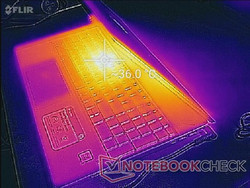
Surface temperatures are flat when idling except on the right palm rest where the 2.5-inch SATA III bay is located. As shown by the temperature maps below, this quadrant can be about 5 degrees C warmer than the left palm rest when the drive is active. It's not enough to be uncomfortable, but the temperature difference will be noticeable when typing or web browsing.
Higher loads will cause the center of the keyboard to become as warm as 36 C while the bottom rear can be as warm as 41 C. The hot spots aren't all that different from the Envy x360 15 with the Ryzen 5 2500U SoC in terms of temperature.
(+) The maximum temperature on the upper side is 35.8 °C / 96 F, compared to the average of 36.9 °C / 98 F, ranging from 21.1 to 71 °C for the class Multimedia.
(±) The bottom heats up to a maximum of 41.4 °C / 107 F, compared to the average of 39.2 °C / 103 F
(+) In idle usage, the average temperature for the upper side is 24.4 °C / 76 F, compared to the device average of 31.3 °C / 88 F.
(+) The palmrests and touchpad are cooler than skin temperature with a maximum of 26.8 °C / 80.2 F and are therefore cool to the touch.
(±) The average temperature of the palmrest area of similar devices was 28.7 °C / 83.7 F (+1.9 °C / 3.5 F).
Speakers
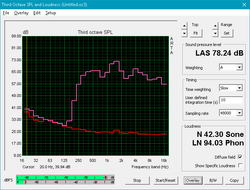
The B&O stereo speakers are decent considering the cheap price of the Pavilion. Sound is balanced although lacking in bass as one would expect. Maximum volume is loud enough to fill a medium-sized room with no static or reverberations.
HP Pavilion 15-cs0053cl audio analysis
(±) | speaker loudness is average but good (72.1 dB)
Bass 100 - 315 Hz
(-) | nearly no bass - on average 19.7% lower than median
(-) | bass is not linear (15.7% delta to prev. frequency)
Mids 400 - 2000 Hz
(+) | balanced mids - only 4.1% away from median
(±) | linearity of mids is average (7.9% delta to prev. frequency)
Highs 2 - 16 kHz
(+) | balanced highs - only 2.1% away from median
(±) | linearity of highs is average (7.3% delta to prev. frequency)
Overall 100 - 16.000 Hz
(±) | linearity of overall sound is average (21.8% difference to median)
Compared to same class
» 76% of all tested devices in this class were better, 5% similar, 19% worse
» The best had a delta of 5%, average was 17%, worst was 45%
Compared to all devices tested
» 61% of all tested devices were better, 7% similar, 32% worse
» The best had a delta of 4%, average was 24%, worst was 134%
Apple MacBook 12 (Early 2016) 1.1 GHz audio analysis
(+) | speakers can play relatively loud (83.6 dB)
Bass 100 - 315 Hz
(±) | reduced bass - on average 11.3% lower than median
(±) | linearity of bass is average (14.2% delta to prev. frequency)
Mids 400 - 2000 Hz
(+) | balanced mids - only 2.4% away from median
(+) | mids are linear (5.5% delta to prev. frequency)
Highs 2 - 16 kHz
(+) | balanced highs - only 2% away from median
(+) | highs are linear (4.5% delta to prev. frequency)
Overall 100 - 16.000 Hz
(+) | overall sound is linear (10.2% difference to median)
Compared to same class
» 7% of all tested devices in this class were better, 2% similar, 91% worse
» The best had a delta of 5%, average was 18%, worst was 53%
Compared to all devices tested
» 4% of all tested devices were better, 1% similar, 94% worse
» The best had a delta of 4%, average was 24%, worst was 134%
Energy Management
Power Consumption
Idling on desktop demands about 5 W to 8 W depending on the brightness and profile setting to be slightly more efficient than some of its competitors as shown in the table below. The dimmer backlight of the display is partly responsible for the higher power efficiency of the HP notebook.
More demanding loads will draw just over 30 W not unlike on the Dell Inspiron 15 with the same i5-8250U CPU. Consumption during maximum load is lower than on medium load due to throttling.
We are able to record a maximum consumption of 45 W from the small (9 x 3.5 x 2.5 cm) 45 W AC adapter. Because of throttling, however, the system can only draw 45 W for a short few seconds before dropping to 32 W as shown by the image to the right. The behavior matches our CineBench loop test from above where scores are highest during the first loop before dropping and stabilizing thereafter.
Note that the higher-end Pavilion 15 SKU with the GeForce MX150 GPU ships with a more capable 65 W AC adapter instead.
| Off / Standby | |
| Idle | |
| Load |
|
Key:
min: | |
| HP Pavilion 15-cs0053cl i5-8250U, UHD Graphics 620, Toshiba MQ04ABF100, TN LED, 1366x768, 15.6" | Asus VivoBook 15 X570UD i5-8550U, GeForce GTX 1050 Mobile, SK hynix PC300 HFS512GD9MND, IPS, 1920x1080, 15.6" | Dell Inspiron 15 5579-9672 i5-8250U, UHD Graphics 620, SK hynix SC311 SATA, IPS, 1920x1080, 15.6" | Acer Aspire 3 A315-41-R7BM R3 2200U, Vega 3, SK Hynix HFS256G39TND-N210A, TN LED, 1920x1080, 15.6" | HP Envy x360 15m-bq121dx R5 2500U, Vega 8, HGST Travelstar 7K1000 HTS721010A9E630, IPS, 1920x1080, 15.6" | LG Gram 15Z980-B.AA78B i5-8550U, UHD Graphics 620, SK Hynix Canvas SC300 512GB M.2 (HFS512G39TNF), IPS LED, 1920x1080, 15.6" | |
|---|---|---|---|---|---|---|
| Power Consumption | -80% | 4% | -19% | -32% | -17% | |
| Idle Minimum * (Watt) | 5.6 | 5.1 9% | 3.9 30% | 5.6 -0% | 5.9 -5% | 3.7 34% |
| Idle Average * (Watt) | 7.1 | 6.3 11% | 6.6 7% | 8.5 -20% | 8.7 -23% | 8.5 -20% |
| Idle Maximum * (Watt) | 7.9 | 10.5 -33% | 9.3 -18% | 8.4 -6% | 10.5 -33% | 10 -27% |
| Load Average * (Watt) | 32.8 | 82.2 -151% | 30.2 8% | 41 -25% | 45.7 -39% | 36 -10% |
| Load Maximum * (Watt) | 30.5 | 103.2 -238% | 33.2 -9% | 44.2 -45% | 49.4 -62% | 48.7 -60% |
| Witcher 3 ultra * (Watt) | 85.9 | 32 | 45.8 |
* ... smaller is better
Battery Life
Battery capacity is small at just 41 Wh compared to 48 Wh and 56 Wh on the Asus VivoBook 15 and Envy x360 15, respectively. Nonetheless, battery life is still respectable at just under 7 hours of non-stop WLAN use.
Charging from near empty to full capacity takes about two hours.
| HP Pavilion 15-cs0053cl i5-8250U, UHD Graphics 620, 41 Wh | Asus VivoBook 15 X570UD i5-8550U, GeForce GTX 1050 Mobile, 48 Wh | Dell Inspiron 15 5579-9672 i5-8250U, UHD Graphics 620, 42 Wh | Acer Aspire 3 A315-41-R7BM R3 2200U, Vega 3, 37 Wh | Dell XPS 15 9570 i7 UHD i7-8750H, GeForce GTX 1050 Ti Max-Q, 97 Wh | HP Envy x360 15m-bq121dx R5 2500U, Vega 8, 55.8 Wh | |
|---|---|---|---|---|---|---|
| Battery runtime | -24% | -7% | -27% | -2% | -19% | |
| Reader / Idle (h) | 12 | 11.2 -7% | 8.9 -26% | 10.9 -9% | ||
| WiFi v1.3 (h) | 7 | 5.3 -24% | 7.3 4% | 5.7 -19% | 9.6 37% | 6.6 -6% |
| Load (h) | 2.2 | 1.8 -18% | 1.4 -36% | 1.3 -41% | 1.3 -41% | |
| Witcher 3 ultra (h) | 1 |
Pros
Cons
Verdict
A key detractor of previous Pavilion 15 laptops was the unattractive budget design language. A quick look at the old 2015 Pavilion 15 versus a MacBook Pro shows why the Pavilion can retail for less than half the price of the Apple. The visual disparity still exists between the new 2018 Pavilion 15 and the latest Apple, but it is nowhere near as bad as it used to be. To the target audience of students and younger users, the notable visual upgrade could make the Pavilion worth considering.
Internally, we're impressed by the Turbo Boost sustainability, low core temperatures, and generally quiet fan. These attributes aren't as common as we'd like especially on expensive Ultrabooks where cooling takes a backseat to thinness and weight.
The poorest aspects of the new Pavilion are its soft keyboard keys, soft trackpad keys, and teetering display. These drawbacks combine to make the Pavilion feel like a cheap laptop despite the new visual design.
In the low-end $600 to $700 range, the Pavilion 15 could be worth a look for users on tight budgets. Avoid the pricier SKUs at all cost since the Envy and Spectre laptops would be the better investments.
HP Pavilion 15-cs0053cl
- 08/05/2018 v6 (old)
Allen Ngo




